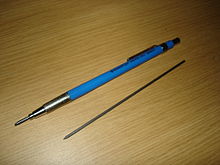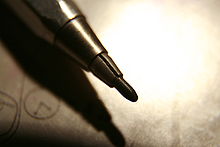- Mechanical pencil
-
A mechanical pencil (U.S. English) or a propelling pencil (UK English)[1][2][3] is a pencil with a replaceable and mechanically extendable solid pigment core called a lead (
 /ˈlɛd/). It is designed such that the lead can be extended as its point is worn away. The lead is not bonded to the outer casing and is usually graphite based, though colored pigments and other solid substances are also used.
/ˈlɛd/). It is designed such that the lead can be extended as its point is worn away. The lead is not bonded to the outer casing and is usually graphite based, though colored pigments and other solid substances are also used. A ratchet-type mechanical pencil
A ratchet-type mechanical pencilMechanical pencils are often designed and used to provide lines of constant thickness without requiring sharpening, making them well suited to applications like technical drawing and fine-point or general writing. They have also, relatively unusually, been used, either with conventional pencils,[4] or by themselves, for fine-art drawing.[5]
Contents
History
The earliest extant example of a mechanical pencil has been found aboard the wreckage of HMS Pandora, which sank in 1791.[6]
The first patent for a refillable pencil with lead-propelling mechanism was issued to Sampson Mordan and John Isaac Hawkins in Britain in 1822. After buying out Hawkins' patent rights, Mordan entered into a business partnership with Gabriel Riddle from 1823 to 1837. The earliest Mordan pencils are thus hallmarked SMGR.[7][8] After 1837, Sampson Mordan ended the partnership with Riddle and continued to manufacture pencils as "S.MORDAN & CO". His company continued to manufacture pencils and a wide range of silver objects until World War II, when the factory was bombed.
Between 1822 and 1874, more than 160 patents were registered pertaining to a variety of improvements to mechanical pencils. The first spring-loaded mechanical pencil was patented in 1877 and a twist-feed mechanism was developed in 1895. The 0.9 mm lead was introduced in 1938, and later it was followed by 0.3, 0.5, 0.7, 0.9. Even 1.3 and 1.4 mm mechanisms were available, and 0.4 and 0.2 versions are now produced.
The mechanical pencil became successful in Japan with some improvements in 1915 by Tokuji Hayakawa, a metal worker who had just finished his apprenticeship. It was introduced as the Ever-Ready Sharp Pencil. Success was not immediate, since the metal shaft—essential for the pencil's long life—was unfamiliar to users. The Ever-Sharp began selling in huge numbers, however, after a company from Yokohama made a large order. Later Tokuji Hayakawa's company got its name from that pencil: Sharp.
At nearly the same time, in America, Charles R. Keeran was developing a similar pencil that would be the precursor of most of today's pencils. Keeran's design was ratchet-based, whereas Hayakawa's was screw-based. These two development histories are often combined into one.
Mechanism types
 A Pentel Sharp ratchet draughting pencil disassembled, showing three 0.5 mm graphite leads.
A Pentel Sharp ratchet draughting pencil disassembled, showing three 0.5 mm graphite leads.
 A Faber-Castell propelling pencil
A Faber-Castell propelling pencil
Mechanical pencils can be divided into two basic types: those that both hold the lead and actively propel it forward during use, and those that only hold the lead in position against gravity.
Propelling pencil
Most mechanical pencils use small sub-millimeter leads and have an internal mechanism that propels the lead forward from a holding chamber inside the barrel. There are a number of different mechanism types:
Ratchet-based pencils are a variant of the clutch pencil, in which the lead is held in place by two or three small jaws inside a ring at the tip. The jaws are controlled by a button on the end or the side of the pencil. When the button is pushed, the jaws move forward and separate, allowing the lead to advance. When the button is released and the jaws retract, the "lead retainer" (a small rubber device inside the tip) keeps the lead in place, prevents the lead from either falling freely outward or riding back up into the barrel until the jaws recover their grip.
- A Ratchet-based pencil is the most popular type of mechanical pencil, and is sold in stores. Variations of this include:
- A variation of the ratchet-based pencil, in which shaking the pencil back and forth causes a weight inside the pencil to operate a mechanism in the cap. A button may be present.
- Another variation advances the lead automatically. In this design, the lead is advanced by a ratchet but only prevented from going back into the pencil, just held from falling by a small amount of friction. The nib is a spring-loaded collar that, when depressed as the lead is worn away, pulls out more when pressure is released.
- A very modern one has a mechanical engine that twists the pencil lead 9 degrees counter clockwise every time the lead is pressed on to the paper to keep the lead 50% less broad than the common propelling mechanical pencils, resulting in uniform thickness of the lines written onto the paper. It was first developed by Mitsubishi Pencil Co.,LTD, and named Kuru Toga.[9]
- Screw-based pencils, in which the lead is advanced by twisting a screw, which moves a slider down the barrel of the pencil. This was the most common type in the earlier part of the twentieth century.
- Screw-based pencils in which the lead is advanced by direct friction with the screw.
- Twist-based pencils, in which the lead advances upon twisting the head of the pencil. Many of these have a locking mechanism one way to allow the lead to be pushed back into the pencil.
Clutch pencil
 A Staedtler Mars 780 Leadholder
A Staedtler Mars 780 Leadholder
A clutch pencil (or leadholder) tends to use thicker leads (2–4 mm) and generally holds only one piece of lead at a time.
A typical clutch pencil is activated by pressing the eraser cap to open the jaws inside the tip, allowing the lead to freely drop through from the barrel (or into it when retracting). Because the lead falls freely when the jaws are opened, its forward movement cannot be controlled except by externally halting its progress. This can be easily done by keeping the tip of the pencil a few millimeters above a work surface or the palm of one's hand.
Some clutch pencils do have mechanisms which incrementally advance the lead, such as the Alvin Tech-Matic leadholder, but are not normally considered to be in the same category as most pencils with propellant mechanisms.
Lead variations
Compared to standard pencils, mechanical pencils have a smaller range of marking types. Nevertheless, numerous variations exist. Most mechanical pencils can be refilled, but some inexpensive models are meant to be disposable and discarded when empty.
Diameter
Mechanical pencil mechanisms use only a single lead diameter. Some pencils, such as the Pentel Function 357, place several mechanisms within the same housing, so as to offer a range of thicknesses, in this case three: 0.3, 0.5 and 0.7 mm.
Different sizes of lead diameters are available to accommodate various preferences and pencil builds, as shown in the table below. The most popular lead sizes are 0.5mm and 0.7mm, whose line widths allow for precise writing and drawing. There are also rare .05, .1, and .2 mm leads.
Pencil Lead Diameters
Diameter Uses 0.2mm technical work 0.3mm technical work 0.4mm technical work 0.5mm general writing, general technical work, beginner’s technical work 0.7mm general writing 0.9mm students/general writing 1.0mm rare, used in pre-1950 Parker pencils 1.18mm older, used in pencils like the Yard-O-Led 1.3mm Pentel manufactures glitter leads in this diameter 1.4mm Faber-Castell e-Motion and the new Lamy ABC as well as some Stabilo children's pencils 2mm drafting leadholders 3.15mm non-drafting leadholders 5.6mm non-drafting leadholders Pencils with sub-millimeter leads can usually hold multiple leads at the same time, reducing the frequency of refills. A notable exception was the Pentel 350 E, possibly Pentel's first mechanical pencil,[10] which could only hold a single stick of 0.5mm lead. Refill leads can be bought in small tubes and inserted into the barrel as needed.
Pigments
As with non-mechanical pencils, the leads of mechanical pencils are available in a range of graphite/binder ratios, depending on the user's desired balance between darkness and durability.
Mechanical pencils with colored leads are relatively rare, but do exist. Crayola's "Twistable" product line includes two different types of colored pencils (erasable and non-erasable) with mechanical feed mechanisms, but does not offer refill leads. Several non-US companies such as Pentel, Pilot, and uni-ball currently manufacture colored refill leads in a limited range of diameters (0.5mm, 0.7mm, or 2mm) for their own products. Koh-i-Noor makes mechanical colored pencils with replaceable leads in 2.0, 3.15 and 5.6mm sizes.[11]
References
- ^ mechanical pencil – definition. American English definition of mechanical pencil by Macmillan Dictionary. Macmillandictionary.com. Retrieved on 2011-10-14.
- ^ propelling pencil. Cambridge Dictionary on-line
- ^ Other names include automatic pencil, drafting pencil, technical pencil, click pencil, clutch pencil, leadholder, pen pencil, and pacer (or spacer).
- ^ "Artistic Realism Art Studio: Graphite pencil, charcoal and pastels fine art by David and Faith Te, works in progress, and updates to www.artisticrealism.com: Archive for the ‘Pencil Drawing Tutorials’". http://www.artisticrealism.com/artstudio/category/pencil-drawing-tutorials. Retrieved 2011-05-26.
- ^ "In the Land of Polio (or Headhunters) he Weeps for and is in Love with the Girl Who Disappeared, mechanical pencil drawing by Daniel C. Boyer". http://www.sito.org/id/dcb/248575_10150610559840232_837005231_19199.jpg. Retrieved 2011-05-27.
- ^ National Geographic Magazine, Vol. 168, No. 4 (October 1985), p. 450 (illustrated p. 451)
- ^ "History of Leadholders". Leadholders.com. 2008-01-04. http://www.leadholder.com/main-history.html. Retrieved 2008-02-27.
- ^ "Sampson Mordan Pencils". Mark Hill Collects: The 20th Century Design and Collectibles Blog. 2009-04-30. http://markhillcollects.blogspot.com/2009/04/sampson-mordan-pencils.html. Retrieved 2009-12-12.
- ^ Kurutoga Website, Amazing lead spinning pencil,Kurutoga.
- ^ "Pentel 350 Series Mechanical Pencil | Leadholder". Leadholder.com. http://www.leadholder.com/lh-thin-pentel-350.html. Retrieved November 14, 2010.
- ^ Koh-I-Noor 2.0mm leadholders and colour leads. pencil talk. Retrieved on 2011-10-14.
Further reading
- Deborah Crosby, Victorian Pencils: Tools to Jewels, Schiffer Publishing Ltd., Atglen, PA, 1998.
- Jonathan A. Veley, "The Catalogue of American Mechanical Pencils", Greyden Press, 2011.
External links
- Early mechanical pencils and whistle combinations.
- Sharp's history of the mechanical pencil
- History and development of Keeran's and Hayakawa's pencil styles
- Leadholder Museum (History and Images of Leadholders)
- Dave's Mechanical Pencils – information and reviews
- Mechanical Pencil Museum Jonathan Veley's Mechanical Pencil Museum
Types ballpoint (biro) · demonstrator · digital · dip · fountain · gel · ink brush · light · porous point · qalam · quill · rastrum · reed · rollerball · ruling · skin · stylus · technical (rapidograph)Parts and tools pen inks Related caligraphy · cartooning · mechanical pencilCategories:- Pencils
- Writing instruments
- A Ratchet-based pencil is the most popular type of mechanical pencil, and is sold in stores. Variations of this include:
Wikimedia Foundation. 2010.




